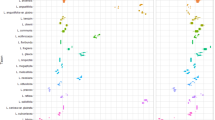Summary
Inbreeding is known to increase developmental instability in outbreeding plants, and it has been argued that phenotypic plasticity in response to environmental variation might be similarly affected. To investigate whether phenotypic plasticity is altered by inbreeding, an outcrossed group and three successive generations of inbred cultivated Phlox drummondii were grown in six different treatments (Control, Low Water, Low Nutrient, Early and Late Leaf Removal, and Small Pots). Twelve plant characters were measured to determine the effects of the treatments and inbreeding. For those characters where inbreeding level by treatment interaction was indicated, the amounts and patterns of plasticity were examined to determine the source of the interaction. Despite substantial evidence for inbreeding depression of plant vigor and fecundity, there was no indication of an increase in the amount of phenotypic plasticity with progressive inbreeding. There was also no evidence that inbreeding systematically disrupts the pattern of plastic response to the environment.
Similar content being viewed by others
References
Allard RW, Bradshaw AD (1964) Implications of genotype-environmental interactions in applied plant breeding. Crop Sci 4:503–508
Bradshaw AD (1965) Evolutionary significance of phenotypic plasticity in plants. Adv Genet 13:115–155
Dowker BD, Fennell JFM (1981) The relative performance of inbreds and open-pollinated populations of spring-sown onions. J Agric Sci 97:25–30
Eberhart SA, Russell WA (1966) Stability parameters for comparing varieties. Crop Sci 6:36–40
Finlay KW, Wilkinson GN (1963) The analysis of adaptation in a plant-breeding programme. Aust J Agric Res 14:742–754
Griffing B, Langridge J (1963) Phenotypic stability of growth in the self-fertilized species, Arabidopsis thaliana. In: Statistical genetics and plant breeding. NAS-NRC Publ 982:368–394
Hollander M, Wolfe DA (1973) Nonparametric Statistical Methods. Wiley and Sons, New York
Kang MS, Miller JD (1984) Genotype X environment interactions for cane and sugar yield and their implications in sugarcane breeding. Crop Sci 24:435–440
Lerner IM (1954) Genetic homeostasis. Dover Publ Inc, NY
Levin DA (1970) Developmental instability and evolution in peripheral isolates. Am Nat 104:343–353
Levin DA (1975) Gametophytic selection in Phlox. In: Mulcahy DL (ed) Gamete competition in plants and animals. North Holland/American Elsevier, Amsterdam NY, pp 207–218
Lewis D (1954) Gene-environment interaction: a relationship between dominance, heterosis, phenotypic stability and variability. Heredity 8:333–356
Pederson DG (1968) Environmental stress, heterozygote advantage and genotype-environment interaction in Arabidopsis. Heredity 23:127–138
Plaisted RL, Peterson LC (1959) A technique for evaluating the ability of selections to yield consistently in different locations or seasons. Am Potato J 36:381–385
Quisenberry JE, Kohel RJ (1971) Phenotypic stability of cotton. Crop Sci 11:827–829
Rendel JM (1967) Canalisation and gene control. Academic Press, London
SAS User's Guide: Statistics (1982) SAS Institute, Cary NC
Schlichting CD, Levin DA (1984) Phenotypic plasticity of annual Phlox: tests of some hypotheses. Am J Bot 71:252–260
Sentz JC, Robinson HF, Comstock RE (1954) Relation between heterozygosis and performance in maize. Agron J 46:514–520
Shukla GK (1972) Some statistical aspects of partitioning genotype-environmental components of variability. Heredity 29:237–25
Soule ME (1982) Allomeric variation. 1. The theory and some consequences. Am Nat 120:751–764
Tai GCC (1979) Analysis of genotype-environment interactions of potato yield. Crop Sci 19:434–438
Williams W (1960) Relative variability of inbred lines and F1 hybrids in Lycopersicum esculentum. Genetics 45:1457–1465
Author information
Authors and Affiliations
Additional information
Communicated by A. L. Kahler
Rights and permissions
About this article
Cite this article
Schlichting, C.D., Levin, D.A. Effects of inbreeding on phenotypic plasticity in cultivated Phlox . Theoret. Appl. Genetics 72, 114–119 (1986). https://doi.org/10.1007/BF00261465
Received:
Accepted:
Issue Date:
DOI: https://doi.org/10.1007/BF00261465




